Abstract
A guanine derivative with an acyclic side chain, 2-hydroxyethoxymethyl, at position 9 has potent antiviral activity [dose for 50% inhibition (ED50) = 0.1 μM] against herpes simplex virus type 1. This acyclic nucleoside analog, termed acycloguanosine, is converted to a monophosphate by a virus-specified pyrimidine deoxynucleoside (thymidine) kinase and is subsequently converted to acycloguanosine di- and triphosphates. In the uninfected host cell (Vero) these phosphorylations of acycloguanosine occur to a very limited extent. Acycloguanosine triphosphate inhibits herpes simplex virus DNA polymerase (DNA nucleotidyltransferase) 10-30 times more effectively than cellular (HeLa S3) DNA polymerase. These factors contribute to the drug's selectivity; inhibition of growth of the host cell requires a 3000-fold greater concentration of drug than does the inhibition of viral multiplication. There is, moreover, the strong possibility of chain termination of the viral DNA by incorporation of acycloguanosine.
The identity of the kinase that phosphorylates acycloguanosine was determined after separation of the cellular and virus-specified thymidine kinase activities by affinity chromatography, by reversal studies with thymidine, and by the lack of monophosphate formation in a temperature-sensitive, thymidine kinase-deficient mutant of the KOS strain of herpes simplex virus type 1 (tsA1).
Keywords: antiviral chemotherapy, virus-specified thymidine kinase, herpes simplex virus, virus-specified DNA polymerase, acycloguanosine triphosphate
Full text
PDF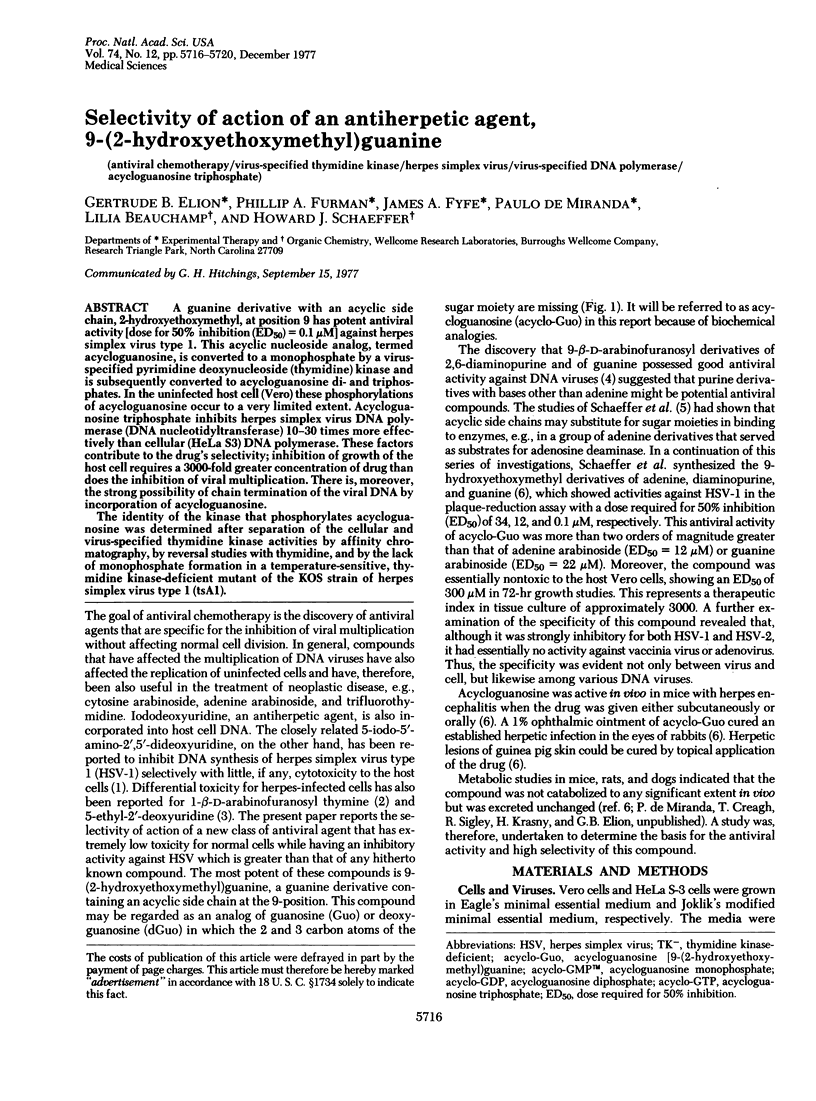
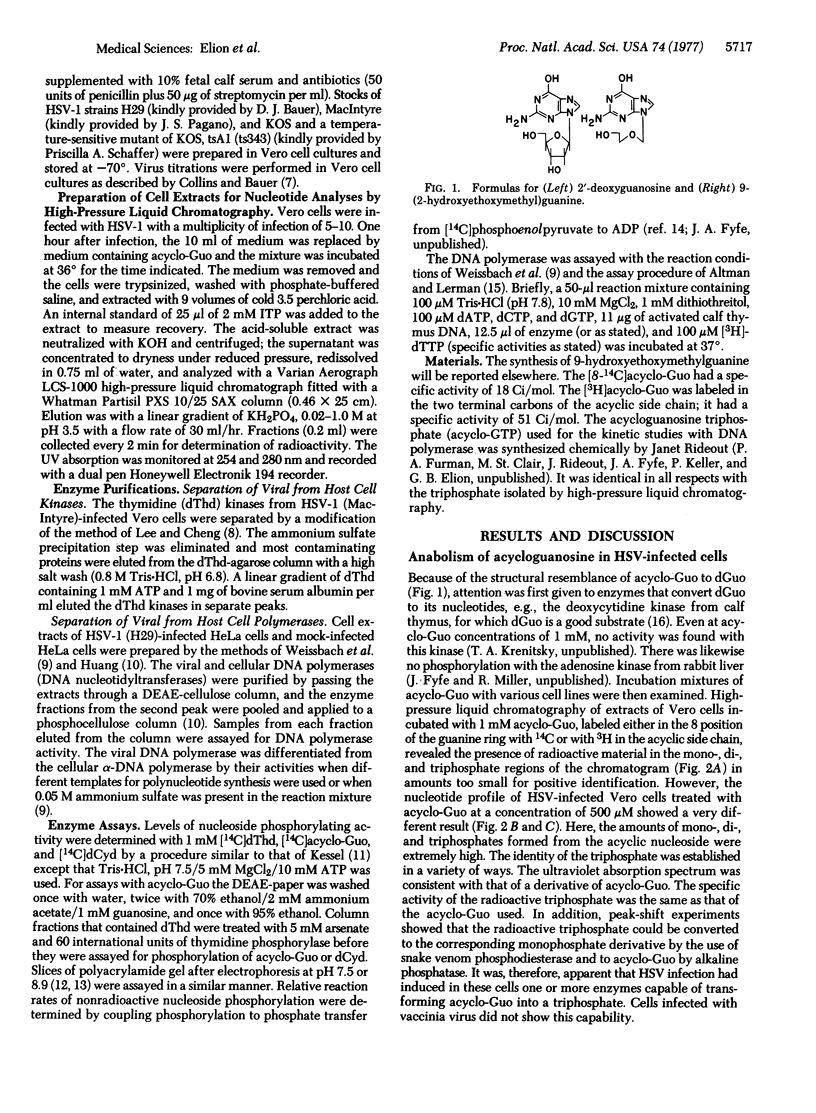
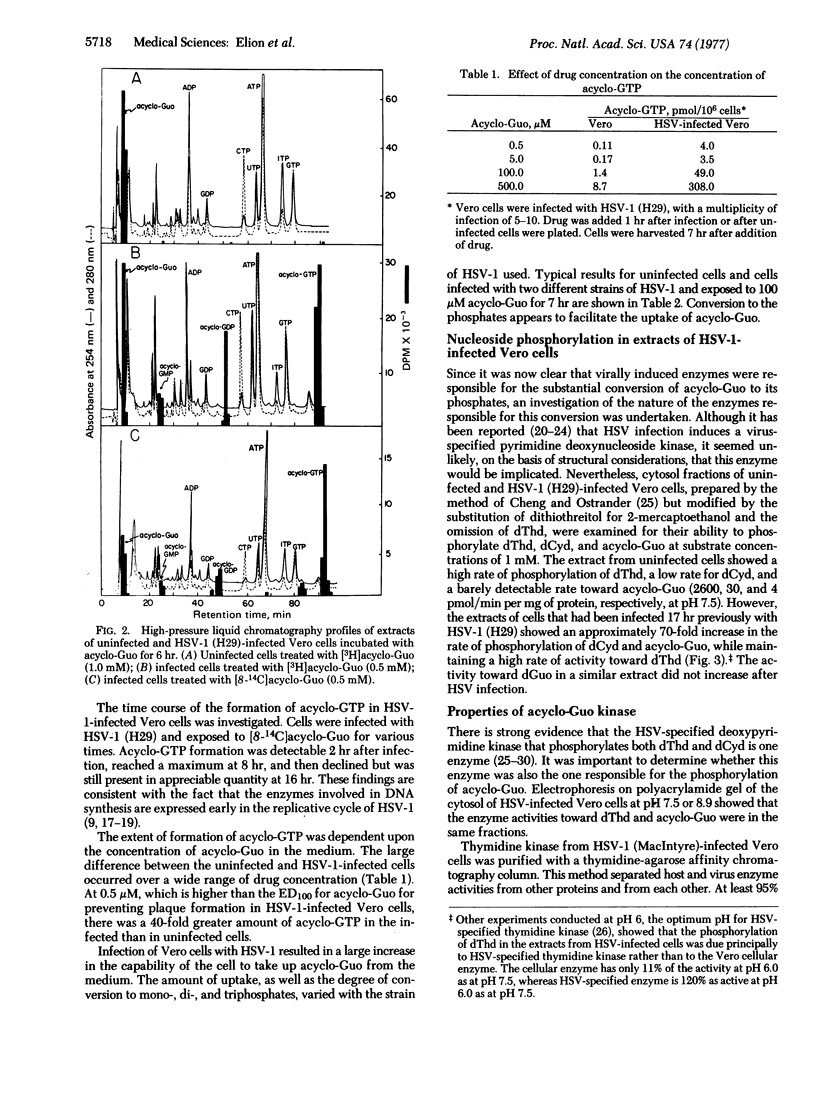
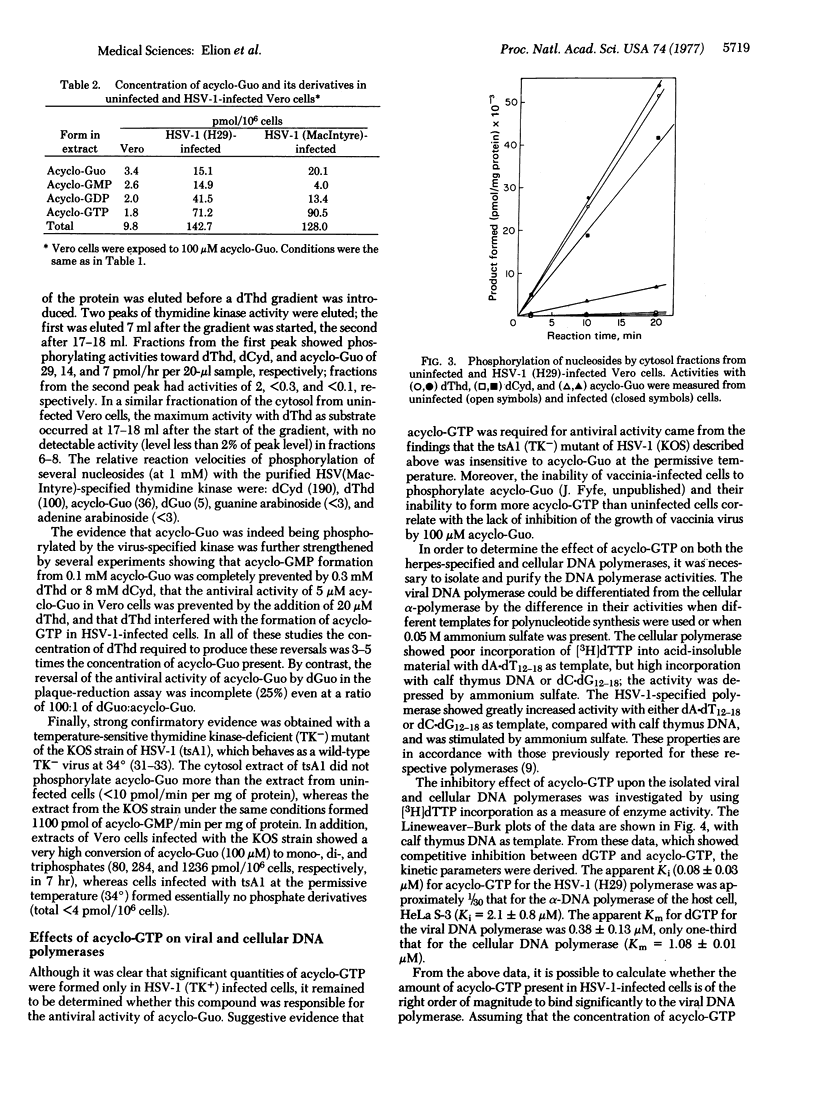
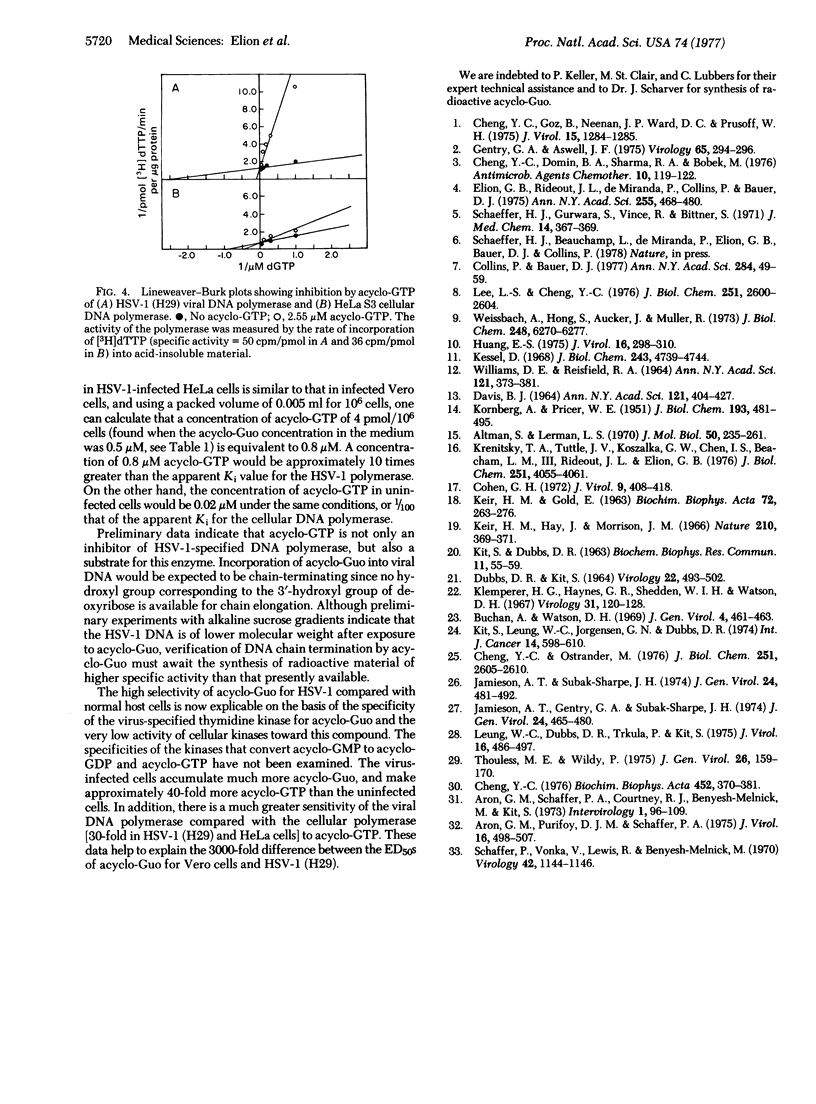
Selected References
These references are in PubMed. This may not be the complete list of references from this article.
- Altman S., Lerman L. S. Kinetics and intermediates in the intracellular synthesis of bacteriophage T4 deoxyribonucleic acid. J Mol Biol. 1970 Jun 14;50(2):235–261. doi: 10.1016/0022-2836(70)90190-7. [DOI] [PubMed] [Google Scholar]
- Aron G. M., Purifoy D. J., Schaffer P. A. DNA synthesis and DNA polymerase activity of herpes simplex virus type 1 temperature-sensitive mutants. J Virol. 1975 Sep;16(3):498–507. doi: 10.1128/jvi.16.3.498-507.1975. [DOI] [PMC free article] [PubMed] [Google Scholar]
- Aron G. M., Schaffer P. A., Courtney R. J., Benyesh-Melnick M., Kit S. Thymidine kinase activity of herpes simplex virus temperature-sensitive mutants. Intervirology. 1973;1(2):96–109. doi: 10.1159/000148836. [DOI] [PubMed] [Google Scholar]
- Buchan A., Watson D. H. The immunological specificity of thymidine kinases in cells infected by viruses of the herpes group. J Gen Virol. 1969 Apr;4(3):461–463. doi: 10.1099/0022-1317-4-3-461. [DOI] [PubMed] [Google Scholar]
- Cheng Y. C. Deoxythymidine kinase induced in the HELA TK- cells by herpes simplex virus type I and type II. Substrate specificity and kinetic behavior. Biochim Biophys Acta. 1976 Dec 8;452(2):370–381. doi: 10.1016/0005-2744(76)90186-8. [DOI] [PubMed] [Google Scholar]
- Cheng Y. C., Domin B. A., Sharma R. A., Bobek M. Antiviral action and cellular toxicity of four thymidine analogues: 5-ethyl-,5-vinyl-, 5-propyl-, and 5-allyl-2'- deoxyuridine. Antimicrob Agents Chemother. 1976 Jul;10(1):119–122. doi: 10.1128/aac.10.1.119. [DOI] [PMC free article] [PubMed] [Google Scholar]
- Cheng Y. C., Goz B., Neenan J. P., Ward D. C., Prusoff W. H. Selective inhibition of herpes simplex virus by 5-amino-2,5-dideoxy-5-iodouridine. J Virol. 1975 May;15(5):1284–1285. doi: 10.1128/jvi.15.5.1284-1285.1975. [DOI] [PMC free article] [PubMed] [Google Scholar]
- Cheng Y. C., Ostrander M. Deoxythymidine kinase induced in HeLa TK- cells by herpes simplex virus type I and type II. II. Purification and characterization. J Biol Chem. 1976 May 10;251(9):2605–2610. [PubMed] [Google Scholar]
- Cohen G. H. Ribonucleotide reductase activity of synchronized KB cells infected with herpes simplex virus. J Virol. 1972 Mar;9(3):408–418. doi: 10.1128/jvi.9.3.408-418.1972. [DOI] [PMC free article] [PubMed] [Google Scholar]
- Collins P., Bauer D. J. Relative potencies of anti-herpes compounds. Ann N Y Acad Sci. 1977 Mar 4;284:49–59. doi: 10.1111/j.1749-6632.1977.tb21936.x. [DOI] [PubMed] [Google Scholar]
- DAVIS B. J. DISC ELECTROPHORESIS. II. METHOD AND APPLICATION TO HUMAN SERUM PROTEINS. Ann N Y Acad Sci. 1964 Dec 28;121:404–427. doi: 10.1111/j.1749-6632.1964.tb14213.x. [DOI] [PubMed] [Google Scholar]
- DUBBS D. R., KIT S. MUTANT STRAINS OF HERPES SIMPLEX DEFICIENT IN THYMIDINE KINASE-INDUCING ACTIVITY. Virology. 1964 Apr;22:493–502. doi: 10.1016/0042-6822(64)90070-4. [DOI] [PubMed] [Google Scholar]
- Elion G. B., Rideout J. L., de Miranda P., Collins P., Bauer D. J. Biological activities of some purine arabinosides. Ann N Y Acad Sci. 1975 Aug 8;255:468–480. doi: 10.1111/j.1749-6632.1975.tb29251.x. [DOI] [PubMed] [Google Scholar]
- Gentry G. A., Aswell J. F. Inhibition of herpes simplex virus replication by araT. Virology. 1975 May;65(1):294–296. doi: 10.1016/0042-6822(75)90034-3. [DOI] [PubMed] [Google Scholar]
- Huang E. S. Human cytomegalovirus. III. Virus-induced DNA polymerase. J Virol. 1975 Aug;16(2):298–310. doi: 10.1128/jvi.16.2.298-310.1975. [DOI] [PMC free article] [PubMed] [Google Scholar]
- Jamieson A. T., Gentry G. A., Subak-Sharpe J. H. Induction of both thymidine and deoxycytidine kinase activity by herpes viruses. J Gen Virol. 1974 Sep;24(3):465–480. doi: 10.1099/0022-1317-24-3-465. [DOI] [PubMed] [Google Scholar]
- Jamieson A. T., Subak-Sharpe J. H. Biochemical studies on the herpes simplex virus-specified deoxypyrimidine kinase activity. J Gen Virol. 1974 Sep;24(3):481–492. doi: 10.1099/0022-1317-24-3-481. [DOI] [PubMed] [Google Scholar]
- KIT S., DUBBS D. R. Acquisition of thymidine kinase activity by herpes simplex-infected mouse fibroblast cells. Biochem Biophys Res Commun. 1963 Apr 2;11:55–59. doi: 10.1016/0006-291x(63)90027-5. [DOI] [PubMed] [Google Scholar]
- KORNBERG A., PRICER W. E., Jr Enzymatic phosphorylation of adenosine and 2,6-diaminopurine riboside. J Biol Chem. 1951 Dec;193(2):481–495. [PubMed] [Google Scholar]
- Keir H. M., Hay J., Morrison J. M., Subak-Sharpe H. Altered properties of deoxyribonucleic acid nucleotidyltransferase after infection of mammalian cells with herpes simplex virus. Nature. 1966 Apr 23;210(5034):369–371. doi: 10.1038/210369a0. [DOI] [PubMed] [Google Scholar]
- Kessel D. Properties of deoxycytidine kinase partially purified from L1210 cells. J Biol Chem. 1968 Sep 25;243(18):4739–4744. [PubMed] [Google Scholar]
- Kit S., Leung W. C., Jorgensen G. N., Dubbs D. R. Distinctive properties of thymidine kinase isozymes induced by human and avian hepresviruses. Int J Cancer. 1974 Nov 15;14(5):598–610. doi: 10.1002/ijc.2910140506. [DOI] [PubMed] [Google Scholar]
- Klemperer H. G., Haynes G. R., Shedden W. I., Watson D. H. A virus-specific thymidine kinase in BHK-21 cells infected with herpes simplex virus. Virology. 1967 Jan;31(1):120–128. doi: 10.1016/0042-6822(67)90015-3. [DOI] [PubMed] [Google Scholar]
- Krenitsky T. A., Tuttle J. V., Koszalka G. W., Chen I. S., Beacham L. M., 3rd, Rideout J. L., Elion G. B. Deoxycytidine kinase from calf thymus. Substrate and inhibitor specificity. J Biol Chem. 1976 Jul 10;251(13):4055–4061. [PubMed] [Google Scholar]
- Lee L. S., Cheng Y. C. Human deoxythymidine kinase. I. Purification and general properties of the cytoplasmic and mitochondrial isozymes derived from blast cells of acute myelocytic leukemia. J Biol Chem. 1976 May 10;251(9):2600–2604. [PubMed] [Google Scholar]
- Leung W. C., Dubbs D. R., Trkula D., Kit S. Mitochondrial and herpesvirus-specific deoxypyrimidine kinases. J Virol. 1975 Sep;16(3):486–497. doi: 10.1128/jvi.16.3.486-497.1975. [DOI] [PMC free article] [PubMed] [Google Scholar]
- Schaeffer H. J., Gurwara S., Vince R., Bittner S. Novel substrate of adenosine deaminase. J Med Chem. 1971 Apr;14(4):367–369. doi: 10.1021/jm00286a024. [DOI] [PubMed] [Google Scholar]
- Schaffer P., Vonka V., Lewis R., Benyesh-Melnick M. Temperature-sensitive mutants of herpes simplex virus. Virology. 1970 Dec;42(4):1144–1146. doi: 10.1016/0042-6822(70)90364-8. [DOI] [PubMed] [Google Scholar]
- Thouless M. E., Wildy P. Deoxypyrimidine kinases of herpes simplex viruses types 1 and 2: comparison of serological and structural properties. J Gen Virol. 1975 Feb;26(2):159–170. doi: 10.1099/0022-1317-26-2-159. [DOI] [PubMed] [Google Scholar]
- WILLIAMS D. E., REISFELD R. A. DISC ELECTROPHORESIS IN POLYACRYLAMIDE GELS: EXTENSION TO NEW CONDITIONS OF PH AND BUFFER. Ann N Y Acad Sci. 1964 Dec 28;121:373–381. doi: 10.1111/j.1749-6632.1964.tb14210.x. [DOI] [PubMed] [Google Scholar]
- Weissbach A., Hong S. C., Aucker J., Muller R. Characterization of herpes simplex virus-induced deoxyribonucleic acid polymerase. J Biol Chem. 1973 Sep 25;248(18):6270–6277. [PubMed] [Google Scholar]


